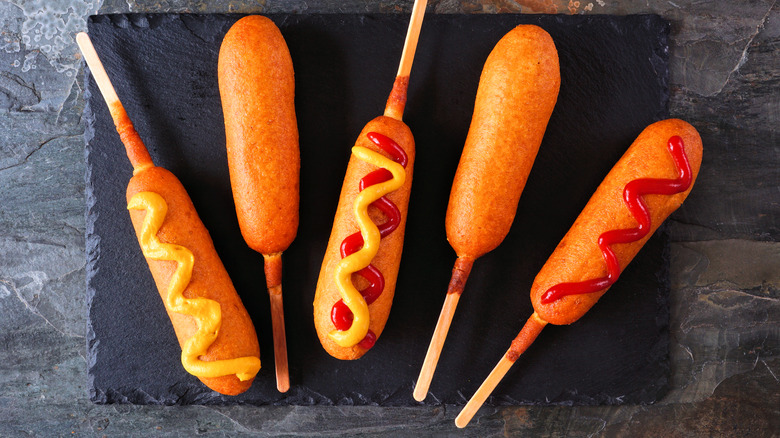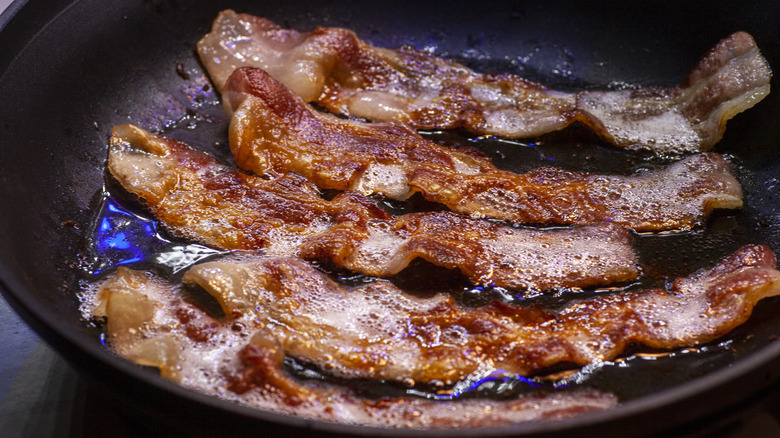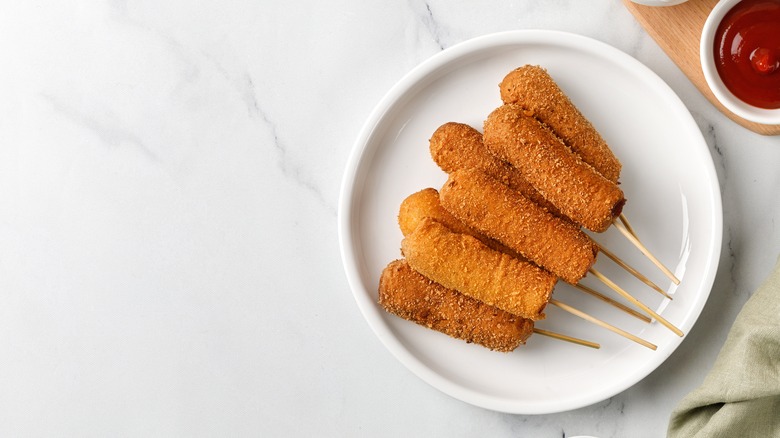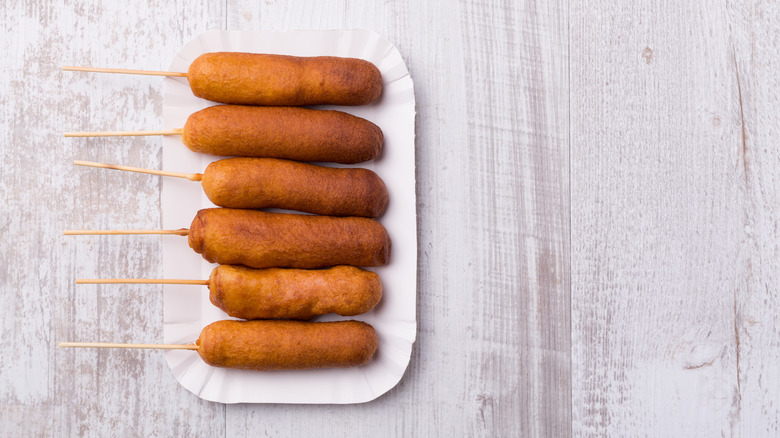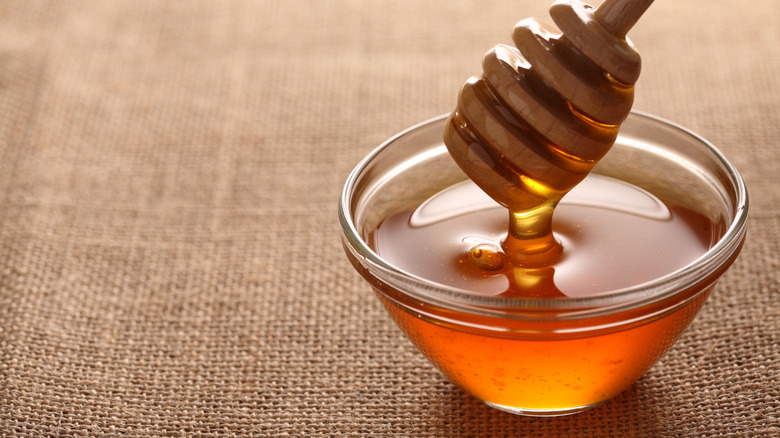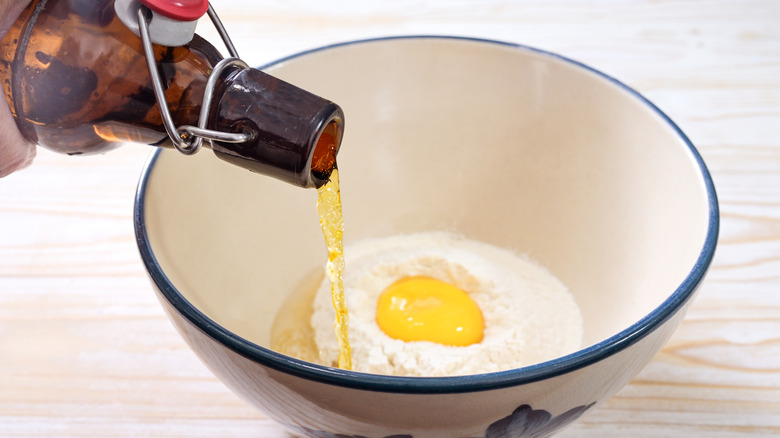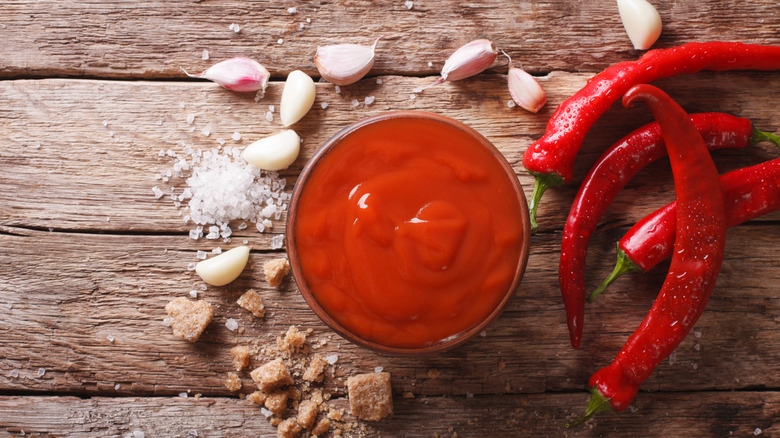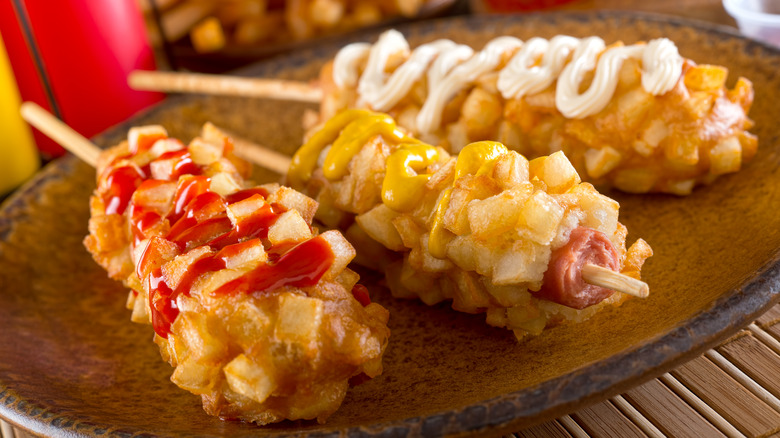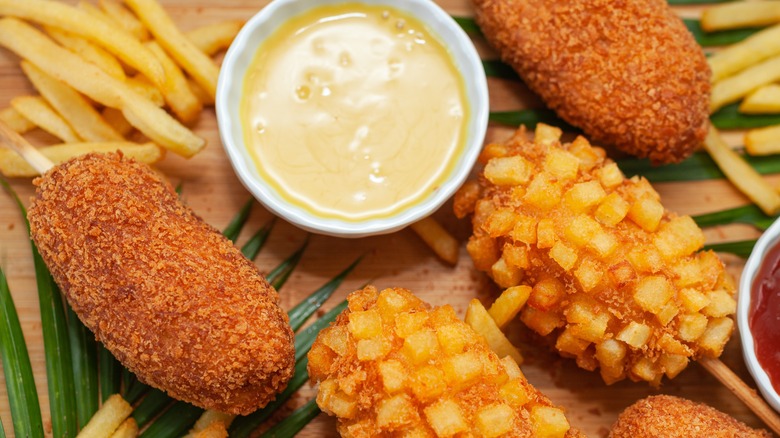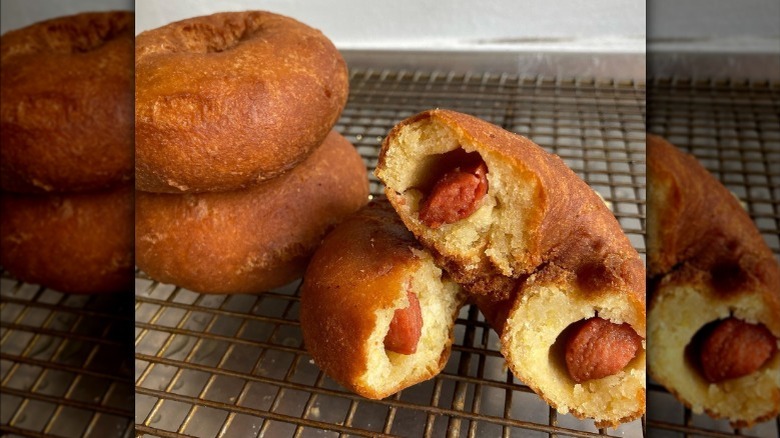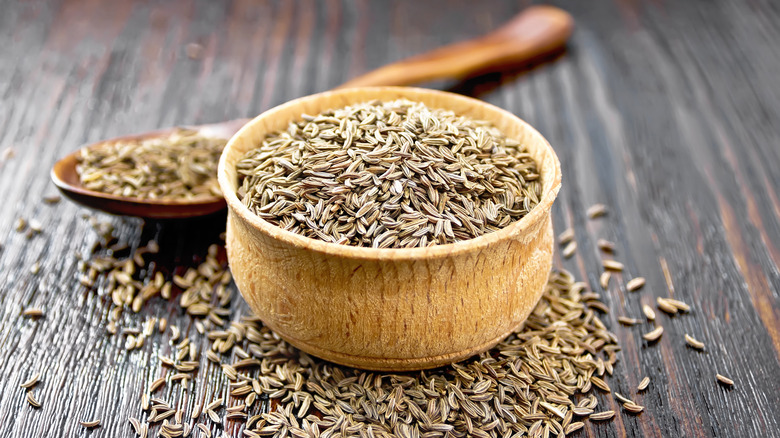12 Ways To Upgrade Corn Dogs
Foods don't get more American than the classic corn dog. This state fair staple, consisting of a hot dog that's been covered in a corn batter and then deep-fried, has been filling bellies since the mid-20th century, when it was allegedly invented by hot dog stand owners George and Vera Boyington. (The corn dog's origin is surprisingly mysterious, though, so it may have been around before then.) Corn dogs are beloved for their sheer simplicity, as well as the ease with which they can be eaten. Instead of having to worry about your hands getting grubby while you contend with a hot dog bun and loads of wet toppings, you munch the snack straight off a stick, minimizing mess and maximizing pleasure.
That's not to say that corn dogs don't have downsides. In their base form, they can be a little boring, with the neutral-tasting corn batter sometimes lacking flavor. While their stick-based serving style is convenient, it can also limit the amount of toppings you can use. If you're thinking that this all means that your corn dogs are destined to be bland, though, don't despair. There are dozens of genius ways to elevate your corn dogs quickly and easily, and we've included our favorites right here.
1. Add some bacon to your batter
Bacon and sausages are a classic combination, but it's hard to get the pairing just right. When incorporated into a hot dog, the temptation can be to wrap the sausage in the bacon and cook them together, but this can leave you with a pretty gross texture and an overly meaty bite. This is even more of a problem if you're planning on then coating the bacon-wrapped hot dog with corn batter — if you leave it raw, there's no guarantee it'll cook through.
The solution, however, is to incorporate bacon directly into your batter. This is easier than it sounds. You simply take some cooked bacon and crumble it directly into your cornmeal batter, before dipping your hot dogs in and deep-frying them. This will leave you with a corn dog that's studded with tiny, crispy bacon pieces, not only improving its flavor and delivering the meat's moreish flavor molecules but giving the snack a slightly knobby, varied texture, ideal for scooping up any dipping sauces.
If you don't have time to make a bespoke bacon batter, though, there's another way you can incorporate bacon flavors. After cooking your corn dogs, drizzle them with a little mayo, and then sprinkle some pre-cooked bacon bits on top. Doing this will give your corn dog a next-level crunch, as well as supreme flavor.
2. Use cake flour instead of regular flour
While one of the main ingredients in corn dogs is, of course, corn, the batter that encases them is not solely made from cornmeal. Instead, corn dogs are covered in a batter made from cornmeal and regular flour, with the latter creating a glueyness that coats the sausage properly.
Most corn dog recipes use regular flour, which does the job — but if you want to amp up the flavor of your dog, use cake flour instead. Cake flour has a lighter consistency than regular flour and is usually milled more finely. It also has a lower protein content than regular flour, which means that it's essentially less glutinous but also that it produces a lighter, more tender crumb. This is ideal for corn dogs, as they can end up being pretty heavy and dense, and using cake flour can give them an airiness and stop them from getting too chewy.
If you don't have any cake flour at home, though, never fear. You can improvise some pretty easily by combining all-purpose flour with cornstarch. For every cup of all-purpose flour you use, just add a couple tablespoons of cornstarch (after removing the same amount of flour), which will give the batter a slight silkiness and lightness when cooked.
3. Bake your corn dogs for a lighter touch
You don't need a dietitian to tell you that corn dogs aren't exactly brimming with nutrition. As a deep-fried food, corn dogs can be pretty high in fat and calories, with a single dog containing almost 40% of your daily fat intake and 311 calories overall. This fat content, too, doesn't just affect the food's nutrition but its taste: Some folks can find that their corn dogs are just way too greasy, overpowering their flavor.
To counteract both of these things and produce light yet crispy corn dogs, bake them instead. Doing this doesn't require any huge changes to your corn dog recipe: You just have to prepare them as you normally would, coating them in a corn-and-flour batter. But then place them on a lined baking sheet and cook them in an oven for around 20 minutes, flipping them halfway through. Make sure your batter is nice and thick when doing this so that it doesn't drip off your dog as it's cooking. Coating them with a little oil can help them produce a well-browned surface.
Bear in mind, though, that this method may produce a corn dog with flatter sides, instead of the cylindrical shape that's achieved when they're deep-fried. As well as this, it might be better to insert your wooden sticks after the corn dogs are cooked, so that they don't singe or burn in the oven.
4. Add some honey to highlight the meat flavors
Corn dogs are savory snacks, and while they have a hint of sweetness from the cornmeal batter, saltiness and umami are the primary flavors. Boosting their sweet notes through the use of honey, though, can introduce an entirely new taste profile that gives the hot dog's flavor even more punch. Sugar and meat are a classic combination, with regular table sugar and honey commonly used to help tenderize meat cuts and assist with caramelization. As well as this, combining sweet flavors with savory and salty ones creates layers of taste, activating our body's flavor receptors more robustly than if just one taste alone is present.
While using honey won't exactly help caramelize the corn dogs, it will give their flavor a massive boost. Once your corn dogs are cooked, dip a pastry brush in honey and give the outside of the dog a light coat. Not only does this give the corn dog honey's mellow, floral taste notes, but the honey can then act as a glue for any other toppings you want, like sesame seeds or bacon bits. If you wish, you can also use honey as an ingredient in any dipping sauce you're whipping up, giving it extra intensity and sweetness.
5. Rustle up your corn dogs with a different serving style
The combination of hot dogs and cornmeal batter isn't limited to one serving method. While corn dogs are usually cooked and dished up impaled on a stick, turning them into muffins is another way to keep them as a handheld snack while eliminating the need for deep-frying. All you do is whip up your batter and then pour it into a muffin tin before pressing a piece of hot dog into the batter blob in each section. Bake the corn dog muffins for around 10 minutes, and you're left with a savory snack that's infinitely lighter than a regular corn dog but just as fun to eat.
Baking your corn dogs in a casserole dish, meanwhile, is a great way to make them into an easy main meal that will serve a group. Corn dog casserole (which is sort of a twist on an English toad in the hole) is as simple as slicing up your hot dogs, mixing them with cornmeal batter, and then baking the mixture in a casserole dish. If you like, you can also use whole hot dogs, which will create a bigger textural contrast. Just bear in mind that corn dog casserole can err somewhat on the dry side, so be ready with your favorite serving sauce.
6. Pour some beer into your batter
Beer is an underused ingredient when it comes to corn dog batter, but in our view, it's a must. The alcoholic drink is commonly used in batter for fish and chips, where it gives the coating a light, airy texture. When it's poured into batter, beer's carbon dioxide floods the mixture, and when it's cooked in oil, this CO2 expands fast, creating pockets of air in the batter that increase the crunch factor and stop it from becoming too chewy.
Given that beer and hot dogs are a natural combo, we're kind of surprised it isn't a standard addition to corn dog batter — especially because it's so easy to incorporate. For beer-battered corn dogs, add one part beer for every two parts of flour and cornmeal. It's best to use a light beer, like a lager, pilsner, or pale ale, as dark ales have a higher sugar content that can contribute to your batter burning. Don't leave your beer batter sitting for too long before you cook it, as you run the risk of the CO2 bubbling out and the batter going flat, ruining the whole point of adding the beer in the first place.
7. Incorporate sriracha for multilayered heat
Spice and heat can elevate corn dogs enormously, cutting through their dense, umami-fied flavor and giving them some much-needed piquancy. While there are several ways to do this — such as by stirring some chili powder into the batter or shaking a few dashes into the mixture — our favorite way to add heat is by employing the power of sriracha, either in a dipping sauce or as a coating on your dog. Sriracha has the dual benefits of providing both spice and sweetness, with the multilayered flavor working with both the sausage and the corn batter. In addition, sriracha contains notes of garlic, which pair well with most sausages' seasoning blends, as well as a pleasing, vinegary tanginess.
The easiest way to use sriracha with your corn dog is to drizzle a little over the top and start munching. Most sriracha bottles come with small nozzles that allow you to squeeze with ease and stop you from using too much on the relatively small surface area of a corn dog. Our preferred way of using it, though, is in a sriracha mayonnaise dipping sauce, made by combining equal parts mayo and sriracha and a squeeze of lemon juice. The mayo adds a creamy element and stops the hot sauce from overpowering every other flavor present.
8. Make your corn dogs Korean-style
American corn dogs are over, folks, and Korean corn dogs are here to stay. Korean corn dogs amp things up in several ways, starting with the filling. Instead of just using sausage, Korean corn dogs can also use blocks or tubes of mozzarella, making, in essence, a mozzarella stick impaled on a skewer and covered in delicious batter. Recipes can also incorporate both hot dogs and mozzarella in one dog, giving you the best of both worlds.
As for the batter, Korean corn dogs' signature uneven texture is achieved by first rolling the filling in the batter and then studding it with cubed potatoes. After this, the corn dog is then rolled in panko breadcrumbs before being deep-fried. This creates a dynamite combination of textures and flavors, with the crunchiness of the panko being offset by the soft, pillowy potato pieces. To finish things off, Korean corn dogs are then dusted with sugar for a salty-sweet taste duo, before being drizzled with your choice of sauces. While Korean corn dogs take a little more prep time to make, you'll be rewarded with a dish that's way more filling and has an undeniably more exciting flavor profile.
9. Use different types of sausages for extra flavor
When making corn dogs, hot dogs are the go-to sausage for most people. Mixing up the sausage you use, though, can add brand-new elements to your snack. Next time you're making corn dogs, try using bratwurst instead. Bratwurst has a coarser, slightly meatier feel than hot dogs, which can make the sausages seem more substantial and arguably more satisfying to chew through. As well as this, bratwurst is frequently seasoned with a blend of herbs and spices, giving it a more dynamic, less salt-forward flavor than regular hot dogs.
Importantly, bratwurst is usually sold raw, whereas hot dogs are precooked and edible straight out of the package. Therefore, if using bratwurst, make sure you cook it beforehand, as the hot oil bath the sausages will receive in the corn dog cooking process may not be strong enough to penetrate to their middles.
There are also different types of hot dogs you can use to spice up your corn dog. Chicken, turkey, and veggie hot dogs can all provide different flavor notes, whereas cheese-filled hot dogs can give the dish extra gooeyness and a creamy, rich flavor.
10. Make a cheese dip for your dogs
While cheese is easy to add to a hot dog, it's more difficult to use with corn dogs. Because corn dogs don't have the vessel of the bun to keep the cheese in place, it's prone to falling straight off its surface and scattering all over the floor. The solution, though, is to make a cheese dip to dunk your corn dogs in. Cheese-based dips are perfect for corn dogs as their creaminess pairs fabulously with the salty sausage, and they also provide some important moisture to the dense dough.
For cheese dips, cream cheese is arguably the easiest base to use, thanks to its smoothness and mild flavor. You can throw pretty much anything you like into a cream cheese base, with acidic elements like lemon juice, chopped pickles, and vinegary hot sauce helping to stop it being too one-note. You can also achieve this tanginess by substituting cream cheese with goat cheese, which also has a slightly briny undertone that works well with the corn dough. If using goat cheese, you may find that you need to thin it out slightly more than if using cream cheese, as it can be slightly more solid and crumbly.
11. Combine your corn dogs with donuts for a sweet treat
Choosing a corn dog or a donut is not a decision we like to make, given how delicious they both are. So why not have both at the same time? Delectable corn dog donuts are easier to make than they look and can be made using your standard corn dog batter, with a bit of extra sugar thrown in to give them some added sweetness — or you can use donut dough for added authenticity.
With this culinary mashup, championed and created by Philadelphia-based bakery Okie Dokie Donuts, the biggest challenge is arguably getting the shape right and bending the hot dog without snapping it. If using donut dough, we would recommend cutting your hot dogs into small pieces and folding them into your ring shape before cooking. If using corn dog batter, which is thinner, try using an easy trick to produce a circular hot dog: Take your dog and slice into it perpendicularly at centimeter intervals, each slice about two-thirds of the way through the meat. Then, cook the hot dog, either by broiling, frying, or steaming it. The sausage should curl into a circular shape, which you can then dip into your batter.
12. Stir spices into your corn dog flour
People don't typically choose corn dogs for subtle, complex flavors — their pleasure is in their punchy, salty smack and pillowy softness. However, that doesn't mean that corn dogs can't be given extra depth. One of the best ways to do this is with the use of warming spices, as celebrity chef Yotam Ottolenghi opts to do. Ottolenghi mixes ground cumin, crushed coriander seeds, and Aleppo chili into his corn dog batter, as well as finely chopped chives. The cumin and coriander give the dogs fragranced notes that complement the savoriness of the sausage, while the chili gives them a hint of heat, and the chives provide brightness.
Spices can also be incorporated into dipping sauces and go especially well mixed into one with a yogurt or cream cheese base. Instead of hot dogs, Ottolenghi also suggests using merguez, a spiced lamb sausage commonly found in Middle Eastern countries and often made with cumin, garlic, and harissa. When you're using hot dogs, though, don't be shy about adding in any other spices you like to use; as regular franks are so versatile, they'll go with pretty much anything.
